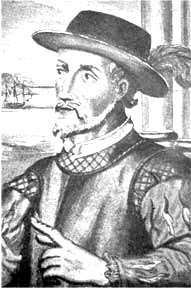Juan Ponce de Leon

Juan Ponce de Leon was born in Santervas de Campos, Spain, in 1460. He participated in the war to conquer Granada. Later, he joined Columbus on his second voyage and played a crucial role in conquering the eastern part of Hispaniola. In recognition of his services, Ponce de Leon was appointed governor of the province.
Having heard rumors of vast wealth on the neighboring island of Puerto Rico, he secured permission to lead an expedition to explore and conquer it. In 1508, he established the first Spanish settlement in Puerto Rico, known as "Caparra." He swiftly gained control over the entire island. The indigenous inhabitants, the Tainos, were subjected to hard labor, and many succumbed to diseases introduced by the Europeans.
In 1511, Ponce de Leon was relieved from his governorship. He then sought and was granted permission to explore territories north of Cuba. Popular lore suggests he was in pursuit of the Fountain of Youth, but the authenticity of this claim remains debated.
On April 2nd, 1513, he landed on a territory he named "Florida," inspired by its abundant flora. It's believed he first set foot just north of present-day Florida. He then traversed its coast from north to south, reaching as far as the Florida Keys.
In 1514, Ponce de Leon returned to Spain and was awarded the Royal Commission to conquer Guadalupe and colonize Florida. Although his 1515 expedition to Guadalupe was unsuccessful, he returned to Puerto Rico. In 1521, he embarked on another journey to establish a permanent colony in Florida. Upon landing on the southwest coast, they were confronted by hostile native inhabitants. Ponce de Leon was injured by a poisoned arrow during a skirmish. The expedition retreated to Cuba, where Ponce de Leon succumbed to his injuries.
.
 >
>